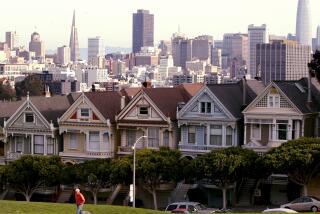2 California Firms Find Back Door Is Open in Vietnam
- Share via
When the Americans fled Saigon in 1975, they left behind U.S. military jeeps, Caterpillar tractors and an ambitious plan to expand the crowded southern capital across the Mekong River into Thu Thiem, a sparsely populated peninsula crisscrossed with canals and rice paddies.
Two decades later, Vietnam’s Communist leaders are resurrecting those ideas in hopes of easing the pressures that their post-Cold War policy of “doi moi,” or economic openness, have placed on the historic downtown core of what is now known as Ho Chi Minh City.
Plenty of American companies would like in on this action. But as with many other opportunities in Vietnam’s fast-developing economy, U.S. firms have been held back by an embargo that was lifted only last year and by obstacles that remain in place--notably a lack of U.S. government-backed financing.
Two California architecture firms, however, have found a back door into Vietnam--through international consortiums backed by governments with a bigger appetite for risk and fewer political constraints such as Taiwan, South Korea and Japan.
Linking up with Asian partners, they have landed major roles as designers of two $1-billion-plus projects that will change the face of Ho Chi Minh City by expanding it to the north and south.
*
Saigon South, a 5,000-acre satellite city along the southern edge of the existing center, was designed by Skidmore, Owings & Merrill in San Francisco. A Taiwanese partner, Central Trading & Development Co., has already started building roads and installing power lines. The third major partner: the Ho Chi Minh City People’s Committee.
“Asians are more comfortable working in [risky] environments,” said John Kriken, a partner in the Skidmore firm.
Earlier this year, a partnership including Chong Kim & Associates, a Los Angeles-based architectural firm, signed a contract to produce a master plan for a satellite city in Thu Thiem that would include a financial center, recreational facilities and housing for foreigners, particularly the returning overseas Vietnamese.
The project is led by South Korea’s giant Samyang Co., which signed an agreement with a Vietnamese community development authority.
These multibillion-dollar development projects are part of an infrastructure boom that is sweeping across Asia as governments struggle to build roads and airports, telephone systems and housing to match their double-digit growth rates. Over the next decade, the World Bank predicts the region will need $1.2 trillion to $1.5 trillion worth of infrastructure to support its dynamic expansion.
For the two Ho Chi Minh City projects, infrastructure alone will exceed $2 billion. But would-be American bidders are hamstrung by concerns in Congress over Vietnam’s alleged human rights abuses and unfair trade practices, which have slowed efforts to remove the remaining barriers to providing special trade privileges and government-backed finance programs for Vietnam.
Continued opposition from the POW/MIA lobby makes it highly unlikely that any further expansion of trade relations with Vietnam will occur during this presidential election year, according to sources in Washington.
U.S. executives complain it is difficult to compete for major infrastructure contracts without government-backed financing, given the high risks of investing in Vietnam, which is hobbled by a primitive legal structure, corruption and excessive government red tape.
*
That need for capital is among the highest barriers to these costly undertakings. In the Thu Thiem and Saigon South projects, the Asian partners are providing the capital to get the projects off the drawing board.
Los Angeles architect Chong Kim, whose firm is designing the Thu Thiem master plan, said his South Korean partners had plenty of construction experience, but were seeking U.S. expertise in managing and marketing a major real estate project.
“They don’t have this type of experience in development,” Kim said.
Chong Kim’s partnership, K&L; International Partners Inc. of Los Angeles, includes Shin Kwang Precision Co., a leading South Korean engineering components firm, and K&L; International Finance, a South Korean investment banking group.
Kim said his South Korean partners view their $2-million investment in the Thu Thiem master plan as a way of ensuring themselves a key role in developing the project’s bridges, roads, energy and water systems and other major infrastructure. Samyang, a major South Korean chaebol that built its industrial empire on the production of polyester fiber, has already landed the contract for a waste-water treatment plant.
K&L; International also has signed a contract to provide 2,000 units of prefabricated housing to help ease the city’s dire housing shortage.
As the hub of Vietnam’s booming southern economy, Ho Chi Minh City is a magnet for foreigners and rural people who are moving to the city in search of jobs. Since the end of the Vietnam War, the city’s population has nearly doubled to 4 million, and continues to grow rapidly.
*
David Faulkner, a partner at Brooke Hillier Parker, Hong Kong-based international property consultants, said the Vietnamese government is not offering terribly high returns to lure investors to its urban development projects. Investors are also wary about Vietnam’s land laws, which restrict foreigners to long-term leases averaging about 40 years.
He said the ventures could be attractive to foreign firms with construction capabilities or other ways of profiting from the infrastructure demands.
“Vietnam is evolving very quickly, but investors are taking a bit of a risk that the government might not change all its regulations as quickly as they’d like,” he said.
Architect Kriken, whose firm won a design competition for the Saigon South project, applauded Vietnam’s top government officials for trying to avoid the urban sprawl and traffic problems of other fast-growing Asian cities such as Taipei, Taiwan, and Bangkok, Thailand, while preserving what is left of Ho Chi Minh City’s historic neighborhoods.
He said Vietnam’s prime minister, Vo Van Kiet, recently ordered the top floors to be lopped off an office building under construction in Ho Chi Minh City when he saw that it towered over the historic City Hall.
By preserving the ornate buildings that are a legacy of French colonial rule, Vietnamese authorities hope to give Ho Chi Minh City a unique urban character that will set it apart from other major Asian cities.
Kriken said the project presented some unique architectural challenges because the area is crisscrossed with canals that serve as neighborhood boundaries, transportation arteries and the municipal sewage system.
As part of the master plan, Skidmore modified the existing waterways to prevent sewage from spilling over into the new neighborhoods. Greenbelts were left along the banks of the waterways to protect wildlife and encourage public use. Pedestrian traffic was encouraged by funneling traffic onto a few main arteries.
Kriken said the fate of Saigon South is tied to Vietnam’s economic restructuring.
“I think the success of Saigon South is absolutely linked to the success of Vietnam,” he said. “This is something that exists as government policy and is completely integrated with their plans.”
More to Read
Inside the business of entertainment
The Wide Shot brings you news, analysis and insights on everything from streaming wars to production — and what it all means for the future.
You may occasionally receive promotional content from the Los Angeles Times.










